J1 League
This article needs additional citations for verification. (May 2010) |
 | |
| Founded | 1992 |
|---|---|
| Country | |
| Confederation | AFC |
| Number of teams | 18 |
| Level on pyramid | 1 |
| Relegation to | J. League Division 2 |
| Domestic cup(s) | Yamazaki Nabisco Cup Emperor's Cup |
| International cup(s) | AFC Champions League Pan-Pacific Championship |
| Current champions | Template:Fb team Grampus (2010) |
| Most championships | Template:Fb team Antlers (7 titles) |
| TV partners | SKY PerfecTV! |
| Website | Official Website |
| Current: 2011 J. League Division 1 | |
The J. League Division 1 (Jリーグ・ディビジョン1, J Rīgu Dibijon1) or J1 League (J1リーグ, J1 Rīgu) is the top division of Japan Professional Football League (日本プロサッカーリーグ, Nippon Puro Sakkā Rīgu) and is the top professional association football league in Japan. It is one of the most successful leagues in Asian club football and the only league given top class 'A' ranking by the AFC. Currently, J. League Division 1 is the first level of the Japanese association football league system. The second tier is represented by J. League Division 2.
History
- For history of Japanese club association football before the inception of the professional league in 1993, see Japan Soccer League.
- For detailed history of J. League Division 2, see J. League Division 2#History.
Phases of J1
| Year | J1 Champions | No. J1 titles [from JSL Era] | ||
|---|---|---|---|---|
| 1993 | Template:Fb team Verdy K | 1 [6] | ||
| 1994 | Template:Fb team Verdy K | 2 [7] | ||
| 1995 | Template:Fb team Marinos | 1 [3] | ||
| 1996 | Template:Fb team Antlers | 1 [1] | ||
| 1997 | Template:Fb team Jubilo | 1 [2] | ||
| 1998 | Template:Fb team Antlers | 2 [2] | ||
| 1999 | Template:Fb team Jubilo | 2 [3] | ||
| 2000 | Template:Fb team Antlers | 3 [3] | ||
| 2001 | Template:Fb team Antlers | 4 [4] | ||
| 2002 | Template:Fb team Jubilo | 3 [4] | ||
| 2003 | Template:Fb team F Marinos | 2 [4] | ||
| 2004 | Template:Fb team F Marinos | 3 [5] | ||
| 2005 | Template:Fb team Gamba | 1 [1] | ||
| 2006 | Template:Fb team Red Diamonds | 1 [5] | ||
| 2007 | Template:Fb team Antlers | 5 [5] | ||
| 2008 | Template:Fb team Antlers | 6 [6] | ||
| 2009 | Template:Fb team Antlers | 7 [7] | ||
| 2010 | Template:Fb team Grampus | 1 [1] | ||
Before the professional league (—1992)
Before the inception of the J. League, the highest level of club football was the Japan Soccer League (JSL), which consisted of amateur clubs. Fans were few, the grounds were not of the highest quality, and the Japanese national team was not on a par with the Asian powerhouses. To raise the level of play domestically, to attempt to garner more fans, and to strengthen the national team, the Japan Football Association (JFA) decided to form a professional league.
The professional association football league, J. League was formed in 1992, with eight clubs drawn from the JSL First Division, one from the Second Division, and the newly formed Shimizu S-Pulse. At the same time, JSL changed its name and became the Japan Football League, a semi-professional league. Although the J. League did not officially launch until 1993, the Yamazaki Nabisco Cup competition was held between the ten clubs in 1992 to prepare for the inaugural season.
Inaugural season and J. League boom (1993–1995)
J. League officially kicked-off its first season with ten clubs on May 15, 1993 as Template:Fb team Verdy K (current, Tokyo Verdy) played host to Template:Fb team Marinos (current, Yokohama F. Marinos) at the Kasumigaoka National Stadium. It made a huge impact on the Japanese sports culture as professional baseball, golf, and sumo were the only well-supported and widely-watched sports in the country. Many famous and post-peak foreign players were brought into the clubs and the stadiums were filling in. On every match day, at least one game was broadcast live on national TV, and it seemed the league was a huge success. In the second season (1994), the league recorded its highest average attendance of 19,598, which is yet to be broken.
Because of such popularity, clubs in the (former) JFL that failed to join "the original ten" in the inaugural season tried to join the league. Clubs like Template:Fb team Jubilo and Template:Fb team Bellmare H (current, Shonan Bellmare) joined the league in 1994, six more clubs followed in next four years.
After the boom (1996–1999)
Despite the success in the first three years, many experts anticipate that "the boom" would soon dissipate, and the league would be in terrible shape financially as the clubs continued paying high wages to the foreign players. In fact, the phenomenon began in early 1996 as the league attendance declined rapidly. In 1997 the average attendance was 10,131, compared to more than 19,000 in 1994. Many claimed that the sudden decline in popularity was also due to rapid expansions; A total of eight clubs were added in the four year span from 1994 to 1998. With high paychecks and low attendance, money was bleeding from the clubs, and the league sponsors were becoming very worried. It seemed that there was no way out from the losses.
Although J. League clubs were no longer corporate-owned, they still depended heavily on support from sponsors, who were thus de facto parent companies. When the Japanese economy took a turn for the worse, clubs suffered as their sponsors were affected. In 1998, Sato Kogyo, a general contractor and primary co-sponsor of Template:Fb team Flugels, announced that it was experiencing financial difficulties, and it would be pulling its support from the club. The other primary co-sponsor, All Nippon Airways, who could not support the club on its own, met with Nissan Motors, the primary sponsor of Template:Fb team Marinos, the Flügels' cross-town rival, and decided to merge their clubs. Under the agreement, the Flügels were dissolved, and the Marinos were renamed Yokohama F. Marinos, the "F." representing the Flügels. To many, this incident signified and symbolized as "the fall of the league" as many other clubs across the league were having similar financial difficulties. Another great example is Fujita canceling a major sponsorship deal with Bellmare Hiratsuka, which ultimately lead to the relegation of the club in 2000. Without a change, it would be just a matter of time before the league collapsed.
Change of infrastructure and game formats (1999–2004)
The league's management finally realized that they were heading in the wrong direction. In order to solve the problem, the management came out with two solutions.
First, they announced the J. League Hundred Year Vision, in which they aim to make 100 professional association football clubs in the nation of Japan by 2092, the hundredth season. The league also encouraged the clubs to promote football or non-football related sports and health activities, to acquire local sponsorships, and to build good relationship with their hometowns at the grass-root level. The league believed that this will allow the clubs to bond with their respective cities and towns and get support from local government, companies, and citizens. In other words, clubs will be able to rely on the locals, rather than major national sponsors.[1]
Second, the infrastructure of the league was heavily changed in 1999. The league acquired nine clubs from the semi-professional JFL and one club from J. League to create a two division system. The top flight became the J. League Division 1 (J1) with 16 clubs while J. League Division 2 (J2) was launched with ten clubs in 1999. The second-tier Japan Football League (former), now became third-tier Japan Football League.
The league also began to follow European game formats as time went on. Originally, due to the cultural unease[citation needed] of neither side coming out as the winner of a game, extra time, golden goal rules, and penalty shoot-outs were employed for regular league matches. Penalty shoot-outs were abolished in the beginning of the 1999 season, and extra time was abolished in 2002 for J2 and 2003 for J1.
Also, until 2004 (with the exception of 1996 season), the J1 season was divided into two. At the end of each full season, the champion from each half played a two-legged series to determine the overall season winner and runners-up. Template:Fb team Jubilo in 2002, and Template:Fb team F Marinos in 2003, won both "halves" of the respective seasons, thus eliminating the need for the playoff series. This was the part of the reason the league abolished the split-season system starting from 2005.
European League Format & AFC Champions League (2005–2008)
Since the 2005 season, J. League Division 1 consisted of 18 clubs (from 16 in 2004) and the season format became similar to the European club football. The number of relegated clubs also increased from 2 to 2.5, with the third-from-bottom club going into promotion/relegation playoffs with the third-placed J2 club. Since then, other than minor adjustments, the top flight has stayed consistent.
Japanese association football clubs have been participating in the AFC Champions League since the 1980s, but for the most part, the Japanese clubs took the Asian competition as an extra burden that took their attention away from the domestic competition. A good example is the 2005 season, where ACL participants Yokohama and Iwata went through 13 consecutive Asian and domestic matches in a span of 44 days, averaging 1 game per 3.66 days. The league declined to ease the fixture pressure from the clubs, whereas Chinese and Korean league moved their domestic games to help their clubs in continental competition. The issue of fixture congestion was finally addressed by the 2006 season.
However in the recent years, with inclusion of A-League in Eastern Asia, introduction of FIFA Club World Cup, and increased marketability in the Asian continent, both the league and the clubs paid more attention to Asian competition. For example, Template:Fb team Frontale built up a notable fan base in Hong Kong, owing to their participation in the Asian Champions League during the 2007 season.[2] Continuous effort led to the success of Template:Fb team Red Diamonds in 2007 and Template:Fb team Gamba in 2008. Thanks to excellent league management and competitiveness in Asian competition, the AFC awarded J. League the highest league ranking and a total of 4 slots starting from the 2009 season. The league took this as an opportunity to sell TV broadcasting rights to foreign countries, especially in Asia.
Also starting the 2008 season, Emperor's Cup Winner was allowed to participate in the upcoming Champions League season, rather than waiting a whole year (i.e. 2005 Emperor's Cup winner, Template:Fb team Verdy, participated in the 2007 ACL season, instead of the 2006 season). In order to fix this one-year lag issue, the 2007 Emperor's Cup winner, Template:Fb team Antlers', turn was waived. Nonetheless, Kashima Antlers ended up participating in the 2009 ACL season by winning the J. League title in the 2008 season.
Modern phase (2009–present)
Three major changes were seen starting in the 2009 season. First, starting this season, four clubs entered the AFC Champions League. Secondly, the number of relegation slots increased to three. Finally, the AFC Player slot was implemented starting this season. Each club will be allowed to have a total of four foreign players; however, one slot is reserved for a player that derives from an AFC country other than Japan.
Future plans (2012—)
There are currently no major plans for J. League Division 1. The number of clubs will most likely stay at 18. Recently, in the Japanese media there has been a rumor of an implementation for a playoff system for J1 Championship or creating new Japanese Premier League with fewer clubs.
Timetable
| Year | Important Events | # J Clubs | # ACL Clubs | Rele. Slots |
|---|---|---|---|---|
| 1989 |
|
|||
| 1990 |
|
|||
| 1992 |
|
|||
| 1993 |
|
10 | ||
| 1994 |
|
12 | ||
| 1995 |
|
14 | ||
| 1996 |
|
16 | ||
| 1997 |
|
17 | ||
| 1998 |
|
18 | ||
| 1999 |
|
16 | 2 | |
| 2000 | 16 | 2 | ||
| 2001 | 16 | 2 | ||
| 2002 | 16 | 2 | 2 | |
| 2003 |
|
16 | 2 | |
| 2004 |
|
16 | 2 | 0.5 |
| 2005 |
|
18 | 2 | 2.5 |
| 2006 |
|
18 | 2 | 2.5 |
| 2007 |
|
18 | 2 | 2.5 |
| 2008 |
|
18 | 2 + 1 | 2.5 |
| 2009 |
|
18 | 4 | 3 |
| 2010 | 18 | 4 | 3 | |
| 2011 |
|
18 | 4 | 3 |
Stance in the Japanese football pyramid
| Level(s) | League(s)/Division(s) |
|---|---|
| I | J. League Division 1 (J1) 18 clubs |
| II | J. League Division 2 (J2) 20 clubs |
| III | Japan Football League 18 clubs |
| IV/V | 9 Regional Leagues 122 clubs |
| VI+ | 46 Prefectural Leagues & 4 Block Leagues of Hokkaido many clubs |
Since the inception of the second division in 1999, promotion and relegation follow a pattern similar to European leagues, where the two bottom clubs of J1 and the top two clubs of J2 are guaranteed to move. From 2004 to 2008 season, the third-placed J2 club entered Promotion/Relegation Series against the sixteenth-placed J1 club and the winner had right to play in the top flight in the following year. Starting 2009 season, top three J2 clubs receives J1 promotion by default in place of three bottom J1 clubs. However, promotion or right to play the now-defunct pro/rele series relies on the J2 clubs meeting the requirements for J1 franchise status set by the league. This has generally not been a hindrance, in fact, no club is yet to be denied promotion due to not meeting the J1 criteria.
Until 2004 season, the J1 season was divided into two halves, with an annual championship series involving the champions from each halves (with exception of the 1996 season). However, from 2005 season, the single-season format is adopted as the top flight was expanded to eighteen clubs. Currently, 18 clubs competes in double round robin, home and away. Starting 2008 season, the top three clubs, along with the Emperor's Cup winner receive ACL berths for the following season. If the Emperor's Cup winner happens to be one of the top three J1 finisher, the 4th-place club receives the final berth. Starting 2009 season, three bottom club are relegated to Division 2 at the end of the year.
2011 season
League Format (2011)
Eighteen clubs will play in double round-robin (home and away) format, a total of 34 games each. A club receives 3 points for a win, 1 point for a tie, and 0 points for a loss. The clubs are ranked by points, and tie breakers are, in the following order:
- Goal differential
- Goals scored
- Head-to-head results
- Disciplinary points
A draw would be conducted, if necessary. However, if two clubs are tied at the first place, both clubs will be declared as the champions. The top three clubs will qualify to the following year's AFC Champions League, while the bottom three clubs will be relegated to J2. Further, the J. League Champions will qualify to the 2011 FIFA Club World Cup as an host, if a Japanese Club does not win the 2011 AFC Champions League.
- Prize Money
- First Place: 200,000,000 Yen
- Second Place: 100,000,000 Yen
- Third Place: 80,000,000 Yen
- Fourth Place: 60,000,000 Yen
- Fifth Place: 40,000,000 Yen
- Six Place: 20,000,000 Yen
- Seventh Place: 10,000,000 Yen
Participating clubs (2011)
Template:J. League Div 1 map 2011
- Pink background denotes club was most recently promoted from J. League Division 2.
- "Year joined" is the year the club joined the J. League (Division 1 unless otherwise indicated).
- "First season in top flight" and "Current spell in top flight" includes seasons in the old Japan Soccer League First Division.
Stadiums (2011)
Primary venues used in the J. League:
| Albirex Niigata | Avispa Fukuoka | Cerezo Osaka | Gamba Osaka | Júbilo Iwata | Kashima Antlers |
|---|---|---|---|---|---|
| Tohoku Denryoku Big Swan Stadium | Level-5 Stadium | Kincho Stadium | Osaka Expo '70 Stadium | Yamaha Stadium | Kashima Soccer Stadium |
| Capacity: 42,300 | Capacity: 22,563 | Capacity: 20,000 | Capacity: 23,000 | Capacity: 16,893 | Capacity: 40,728 |
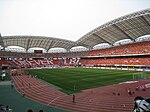
|

|

|

|

|

|
| Kashiwa Reysol | Kawasaki Frontale | Montedio Yamagata | Nagoya Grampus | Omiya Ardija | Sanfrecce Hiroshima |
| Hitachi Kashiwa Soccer Stadium | Todoroki Athletics Stadium | Yamagata Park Stadium | Toyota Stadium | Ōmiya Park Soccer Stadium | Hiroshima Big Arch |
| Capacity: 15,900 | Capacity: 25,000 | Capacity: 20,315 | Capacity: 45,000 | Capacity: 15,500 | Capacity: 50,000 |

|
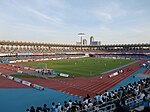
|

|
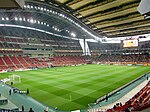
|

|

|
| Shimizu S-Pulse | Urawa Red Diamonds | Vegalta Sendai | Ventforet Kofu | Vissel Kobe | Yokohama F. Marinos |
| Nihondaira Sports Stadium | Saitama Stadium | Sendai Stadium | Kose Sports Stadium | Home's Stadium Kobe | Nissan Stadium |
| Capacity: 20,339 | Capacity: 63,700 | Capacity: 19,694 | Capacity: 17,000 | Capacity: 30,132 | Capacity: 72,370 |

|

|

|
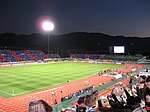
|
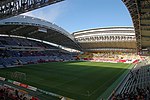
|

|
Game History
Championship History
- Most successful clubs
| Club | Champions | Runners-Up | Winning Seasons | Runners-Up Seasons |
|---|---|---|---|---|
| Template:Fb team Antlers | 1996, 1998, 2000, 2001, 2007, 2008, 2009 | 1993, 1997 | ||
| Template:Fb team Jubilo | 1997, 1999, 2002 | 1998, 2001, 2003 | ||
| Template:Fb team F Marinos | 1995, 2003, 2004 | 2000, 2002 | ||
| Template:Fb team Verdy | 1993, 1994 | 1995 | ||
| Template:Fb team Red Diamonds | 2006 | 2004, 2005, 2007 | ||
| Template:Fb team Grampus | 2010 | 1996 | ||
| Template:Fb team Gamba | 2005 | 2010 | ||
| Template:Fb team Frontale | 2006, 2008, 2009 | |||
| Template:Fb team Sanfrecce | 1994 | |||
| Template:Fb team S-Pulse | 1999 |
Relegation History
- The 1998 Season
When the league introduced the two-division system in 1999, they also reduced number of Division 1 club from 18 to 16. At the end of 1998 season, they hosted the J.League Promotion Tournament to determine two relegating clubs from J.League. Originally, tournament was supposed to have six participants; Kawasaki Frontale from Japan Football League (former) and five bottom clubs from very-complex combined ranking of 1997 and 1998 J.League seasons. However, Yokohama Flügels merged with Yokohama Marinos reducing the number J.League club to 17. Thus, the league took bottom four clubs from J.League and Kawasaki Frontale and decided that three survivor will join J.League Division 1 and two non-survivor will relegate/join the Division 2. As a results, Kawasaki Frontale failed to win J1 promotion and Consadole Sapporo became the first club in J.League history to relegate to J2. These two clubs and other eight clubs from JFL (former) were brought up to create the division 2.
- Split-Season Era (1999–2004)
During the 1999 to 2003 seasons, two bottom clubs clubs were relegated to Division 2. To accommodate for split-season format, combined overall standings were used to determine the relegating clubs. This created a confusing situation, where for championship race stage standing were used, while overall standing was used for relegation survival.
At end of the 2004 season, Division 1 again expanded from 16 clubs to 18 clubs. No clubs were relegated; however, last-placed (16th) club had to play Promotion/Relegation Series against 3rd placed club from J2. Again, to determined 16th placed club, overall standing was used instead of stage standing.
- Single Season Era (2005–present)
From 2005 to 2008 seasons, number of relegating club increased 2.5. To accommodate for two incoming Division 2 clubs, two bottom clubs were relegated; the only difference is that now 18 clubs is competing instead of 16 clubs. Also, during this 4 seasons the 16th-placed club had to play and win Promotion/Relegation Series against 3rd-placed club from J2 to ensure their spot in J1 next year.
Starting in 2009, three teams will be relegated from J1 and three promoted from J2 by default.
- Summary
| Year | 15th Place | 16th Place | 17th Place | 18th Place |
|---|---|---|---|---|
| 1998 | Template:Fb team JEF I | Template:Fb team Consadole | Template:Fb team Vissel | Template:Fb team Avispa |
| 1999 | Template:Fb team Red Diamonds | Template:Fb team Bellmare H | ||
| 2000 | Template:Fb team Purple Sanga | Template:Fb team Frontale | ||
| 2001 | Template:Fb team Avispa | Template:Fb team Cerezo | ||
| 2002 | Template:Fb team Sanfrecce | Template:Fb team Consadole | ||
| 2003 | Template:Fb team Vegalta | Template:Fb team Purple Sanga | ||
| 2004 | Template:Fb team Cerezo | Template:Fb team Reysol † | ||
| 2005 | Template:Fb team S-Pulse | Template:Fb team Reysol ‡ | Template:Fb team Verdy 1969 | Template:Fb team Vissel |
| 2006 | Template:Fb team Ventforet | Template:Fb team Avispa ‡ | Template:Fb team Cerezo | Template:Fb team Purple Sanga |
| 2007 | Template:Fb team Ardija | Template:Fb team Sanfrecce ‡ | Template:Fb team Ventforet | Template:Fb team Yokohama FC |
| 2008 | Template:Fb team JEF | Template:Fb team Jubilo † | Template:Fb team Verdy | Template:Fb team Consadole |
| 2009 | Template:Fb team Montedio | Template:Fb team Reysol | Template:Fb team Trinita | Template:Fb team JEF |
| 2010 | Template:Fb team Vissel | Template:Fb team FC Tokyo | Template:Fb team Sanga | Template:Fb team Bellmare |
* Bold designates relegated clubs; † Won the Pro/Rele Series; ‡ Lost the Pro/Rele Series and relegated
Other tournaments
- Domestic Tournaments
- Emperor's Cup (1921–present)
- JOMO All-Stars Soccer (1993–present)
- XEROX Super Cup (1994–present)
- Yamazaki Nabisco Cup(1992–present, excluding 1995)
- International Tournaments
- FIFA Club World Cup (2007–2008, 2011–2012)
- AFC Champions League (1969, 1986/87-2002/03, 2004–present)
- Suruga Bank Championship (2008–present)
- Defunct Tournament
- A3 Champions Cup (2003–2007)
- Pan-Pacific Championship (2008, 2009)
- Promotion/Relegation Series (2004–2008)
- Sanwa Bank Cup (1994–1997)
- Suntory Championship (1993–2004, excluding 1996)
J. League awards
- Manager of the Year Award
- Most Valuable Player Award
- Rookie of the Year Award
- The Best Eleven
- Top Scorer Award
Players and managers
Players
- List of J. League players
- List of J-League players from AFC
- List of J-League players from CAF
- List of J-League players from CONCACAF
- List of J-League players from CONMEBOL
- List of J-League players from Japan
- List of J-League players from OFC
- List of J-League players from UEFA
Managers
Media coverage
In Australia the J-League is broadcast by Setanta Sports.
See also
- J. League contracts
- J. League records
- Winning Eleven (Official video game)
References
- ^ Fußball im Land der aufgehenden Sonne - Die Entwicklung der japanischen Liga
- ^ "川崎Fが香港でブレーク中、生中継で火" (in Japanese). NikkanSports. March 8, 2008. Retrieved March 8, 2008.
